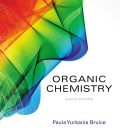
(a)
Interpretation:
- The possibilities of different mono- and di-substuituted compounds for the given two compounds has to be predicted.
Concept Introduction:
Disubstituted compounds: By replacing two hydrogens and replacing with the some other two atoms gives rise to disubstituted compounds.
Monosubstituted compounds: By replacing a hydrogen from the given compound with other atom gives rise to possible number of monosubstituted compounds.
b)
Interpretation:
- The possibilities of different mono- and di-substuituted compounds for the given two compounds has to be predicted.
Concept Introduction:
Disubstituted compounds: By replacing two hydrogens and replacing with the some other two atoms gives rise to disubstituted compounds.
Monosubstituted compounds: By replacing a hydrogen from the given compound with other atom gives rise to possible number of monosubstituted compounds.
c)
Interpretation:
- The possibilities of different mono- and di-substuituted compounds for the given two compounds has to be predicted.
Concept Introduction:
Disubstituted compounds: By replacing two hydrogens and replacing with the some other two atoms gives rise to disubstituted compounds.
Monosubstituted compounds: By replacing a hydrogen from the given compound with other atom gives rise to possible number of monosubstituted compounds.
Trending nowThis is a popular solution!

Chapter 8 Solutions
EBK ORGANIC CHEMISTRY
- What is the name of the following compound? SiMe3arrow_forwardK Draw the starting structure that would lead to the major product shown under the provided conditions. Drawing 1. NaNH2 2. PhCH2Br 4 57°F Sunny Q Searcharrow_forward7 Draw the starting alkyl bromide that would produce this alkyne under these conditions. F Drawing 1. NaNH2, A 2. H3O+ £ 4 Temps to rise Tomorrow Q Search H2arrow_forward
 ChemistryChemistryISBN:9781305957404Author:Steven S. Zumdahl, Susan A. Zumdahl, Donald J. DeCostePublisher:Cengage Learning
ChemistryChemistryISBN:9781305957404Author:Steven S. Zumdahl, Susan A. Zumdahl, Donald J. DeCostePublisher:Cengage Learning Chemistry: The Molecular ScienceChemistryISBN:9781285199047Author:John W. Moore, Conrad L. StanitskiPublisher:Cengage LearningChemistry: Matter and ChangeChemistryISBN:9780078746376Author:Dinah Zike, Laurel Dingrando, Nicholas Hainen, Cheryl WistromPublisher:Glencoe/McGraw-Hill School Pub Co
Chemistry: The Molecular ScienceChemistryISBN:9781285199047Author:John W. Moore, Conrad L. StanitskiPublisher:Cengage LearningChemistry: Matter and ChangeChemistryISBN:9780078746376Author:Dinah Zike, Laurel Dingrando, Nicholas Hainen, Cheryl WistromPublisher:Glencoe/McGraw-Hill School Pub Co Chemistry for Today: General, Organic, and Bioche...ChemistryISBN:9781305960060Author:Spencer L. Seager, Michael R. Slabaugh, Maren S. HansenPublisher:Cengage Learning
Chemistry for Today: General, Organic, and Bioche...ChemistryISBN:9781305960060Author:Spencer L. Seager, Michael R. Slabaugh, Maren S. HansenPublisher:Cengage Learning World of Chemistry, 3rd editionChemistryISBN:9781133109655Author:Steven S. Zumdahl, Susan L. Zumdahl, Donald J. DeCostePublisher:Brooks / Cole / Cengage Learning
World of Chemistry, 3rd editionChemistryISBN:9781133109655Author:Steven S. Zumdahl, Susan L. Zumdahl, Donald J. DeCostePublisher:Brooks / Cole / Cengage Learning





